Hydrostatics Long Answer Type Question And Answers
Question 1. How can a body be cut easily with the sharp edge of a knife, but not with its blunt edge?
Answer: T
The working of a knife depends on the pressure, i. e., the force per unit area. We know that pressure (p) = \(\frac{\text { force }(F)}{\text { area }(A)}\); so keeping F constant, if we decrease A,p will increase.
Now, the surface area of the blunt edge of a knife is more than that of the sharp edge. As a result, for the same force, the blunt edge produces less pressure, but the sharp edge creates a much higher pressure. For this reason, a body can be cut easily with the sharp edge of a knife.
Question 2. During the construction of a dam, why is the bottom of the dam wall made thicker than the top?
Answer:
The lateral pressure of water depends on the depth of water. With increase in the depth, the lateral pressure increases. The depth of water at the top of a dam is less and hence the lateral pressure of water is also less. But due to the maximum depth of water at the bottom of a dam, the lateral pressure of water is the maximum there. To withstand such enormous pressure, the bottom of the dam wall is made thicker.
Question 3. Some liquid is kept in a container inside an artificial satellite revolving in a circular orbit around the Earth. What will be the pressure at a point inside the liquid?
Answer:
Some liquid is kept in a container inside an artificial satellite revolving in a circular orbit around the Earth.
We know that a body becomes weightless when placed inside an artificial satellite revolving around the earth. For this reason, the liquid inside the satellite has no weight, and hence no pressure develops at any point within the liquid. However, there is the gravitational attraction of the satellite itself. This force on the liquid is so low that the pressure due to this is negligible.
Question 3. A cylindrical vessel is filled with a liquid such that the thrust on the bottom of the vessel and that on Its side wall become equal. Prove that the height of the liquid column in the cylinder is numerically equal to the radius of the vessel.
Answer:
A cylindrical vessel is filled with a liquid such that the thrust on the bottom of the vessel and that on Its side wall become equal.
Let the height of the liquid column in the vessel = h, the radius of the cylindrical vessel = r, and the density of the liquid = ρ.
∴ The weight of the liquid in the cylinder = πr²h x ρ x g
∴ Thrust on the base of the cylinder = weight of the liquid in the cylinder = πr²hρg ……(1)
Now, the average pressure on the wall of the cylinder
=1/2 x hρg, area of the curved surface of the cylinder = 2 πrh.
Total thrust on the wall of the cylinder
= \(\frac{1}{2} h \rho g \times 2 \pi r h=\pi r h^2 \rho g\)
According to the problem, from equations (1) and (2), we get
∴ \(\pi r^2 h \rho g=\pi r h^2 \rho g \quad \text { or, } r=h\)
i. e., the radius of the cylinder will be equal to the height of the liquid column.
Question 5. A large shallow wooden container is filled with water. But the container does not crack. A hole is then made on the surface of the container and a long narrow tube is inserted vertically into the container through this hole. The tube Is now filled with water. It is seen that the container now cracks. Explain why.
Answer:
A large shallow wooden container is filled with water. But the container does not crack. A hole is then made on the surface of the container and a long narrow tube is inserted vertically into the container through this hole. The tube Is now filled with water.
The thrust exerted by the liquid on the bottom of the container depends on the base area and the depth of the liquid in it, but not on the quantity of liquid kept in that vessel.
- In the present problem, initially, the depth (h) of water in the container was not large before the inclusion of the tube, although the amount of water in it was large enough. It produced less thrust on the bottom of the container hence the container did not crack.
- When the narrow tube is filled with water, up to the height (h + H), the water column increases considerably. It exerts a large thrust on the base of the container, and so the container cracks.
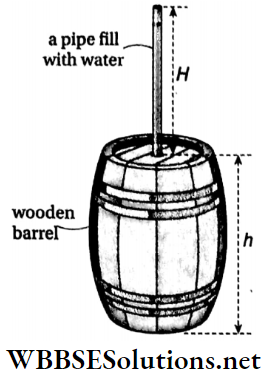
Question 6. A vessel full of liquid is descending with an acceleration a [a < g]. Find the relation between the liquid pressure with the depth of the liquid in the vessel.
Answer:
A vessel full of liquid is descending with an acceleration a [a < g].
Let the density of the liquid = ρ, area of crosssection of the vessel = α, mass of the liquid =m, and pressure at a depth h inside the liquid = p.
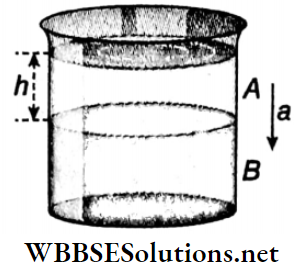
The upward reaction force exerted on the liquid in part A by the liquid in part B = pα.
So, considering the motion of the liquid in part A, we get mg- pa = ma
or, pa = mg-ma = m(g-a) = ahp(g-a)
or, p = hpρ(g- a).
Question 7. A cylindrical vessel contains a liquid up to a height h. A hole is made on the wall of the vessel. Water I comes out through the hole and falls at a distance x from the base of the vessel. At what depth should the hole be created so that x becomes maximum?
Answer:
A cylindrical vessel contains a liquid up to a height h. A hole is made on the wall of the vessel. Water I comes out through the hole and falls at a distance x from the base of the vessel.
Suppose a hole is made at a depth y from the free surface of the liquid and the horizontal velocity of efflux of water through the hole is v.
∴ ν = √2gy
Suppose the liquid takes r second to fall at a distance x from the base of the vessel. Considering the vertical motion of the ejected liquid, we get
h-y = \(\frac{1}{2} g t^2 \text { or, } t^2=\frac{2(h-y)}{g}\)
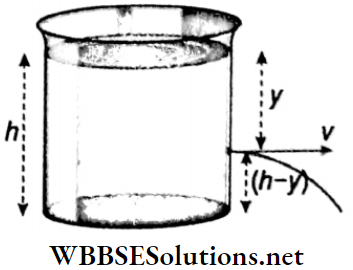
Considering the horizontal motion of the ejected liquid, we get
x = νt or, x = √2gyt
or, \(x^2=2 g y t^2=2 g y \cdot \frac{2(h-y)}{g}=4 y(h-y)\)…….(1)
Now, for the maximum value of x, x2 is also maximum, and hence \(\frac{d}{d y}\left(x^2\right)=0\).
So, differentiating equation (1) with respect to y. we get
⇒ \(\frac{d}{d y}\left(x^2\right)=4(h-y)+4 y(-1)=4(h-2 y)\)
∴ \(h-2 y=0\) or, \(y=\frac{h}{2}\)
Hence, for the maximum range of the water coming out of the hole, the hole should be made at a depth of h/2.
Question 8. Prove that In static equilibrium the pressure exerted by a fluid decreases with its height.
Answer:
Let us assume two layers at heights h and h + dh from the base inside a fluid. Let the density of the fluid = ρ. A part having unit cross-sectional area and thickness dh is considered.
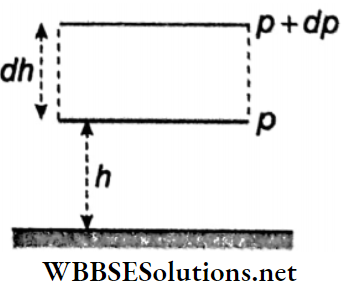
So, the mass of the part = ρdh.
Let the upward pressure on this part be p and the downward pressure = p + dp.
∴ In equilibrium, (p+dp)-p + (ρdh·g) = 0 or, \(\frac{d p}{d h}=-\rho g\)
or, \(\frac{d p}{d h}\) is negative, which indicates that with increase in h, the dh value of p decreases.
So, it is seen that the pressure exerted by the fluid decreases with its height from the base.
Question 9. Two holes are made on the wall and at the bottom of a cylindrical vessel. Now the two holes are dosed with two corks and the vessel is filled with water. If the vessel is now allowed to fall under gravity and the two holes are opened during its flight, then state what will happen.
Answer:
Two holes are made on the wall and at the bottom of a cylindrical vessel. Now the two holes are dosed with two corks and the vessel is filled with water. If the vessel is now allowed to fall under gravity and the two holes are opened during its flight,
We know that a body falling freely under gravity experiences weightlessness. So, the vessel filled with water remains weightless while it is falling under gravity. Then, the upper layers of the liquid exert no pressure on the lower layers and hence there is no pressure difference in the vessel. As a result, no water will come out through the two holes.
Question 10. State whether pressure applied on any part of a confined liquid is transmitted instantaneously to different parts of the liquid. Also, state whether Pascal’s law is applicable.
Answer:
The pressure applied on any part of a confined liq¬uid does not reach different points of the liquid at once. The applied pressure is transmitted through compression and rarefaction within the liquid, and hence, with the velocity of sound. During the transmission of pressure, Pascal’s law is inapplicable. Pascal’s law is valid once the system comes to an equilibrium.
Question 11. Does a hydraulic press work, if the liquid used in it is replaced by a gas?
Answer:
The thrust applied will no doubt be multiplied if the liquid used in a hydraulic press is replaced by a gas. But, due to the greater compressibility of a gas, the thrust developed on the larger piston will not be large enough. For this reason, the press cannot be used for efficient pressing.
Question 12. Does the density have any significance in the weight-less state?
Answer:
Density = \(\frac{\text { mass }}{\text { volume }} \); the quantity of matter contained in a body is called its mass. This mass remains the same even in the weightless state of the body and hence the density of the substance remains unchanged.
Question 13. A long cylinder is fitted with a tap on its wall at its lower end. Keeping the tap closed, the cylinder is filled with water. Now the cylinder is made to float by placing it over a cork and then the tap is opened. State what will happen.
Answer:
A long cylinder is fitted with a tap on its wall at its lower end. Keeping the tap closed, the cylinder is filled with water. Now the cylinder is made to float by placing it over a cork and then the tap is opened.
Due to the lateral pressure of water, it will be seen that a jet of water comes out through the opening of the tap. If the opening of the tap is in the horizontal direction, then the water jet will come out horizontally. Due to an equal but opposite reaction of this thrust, the cylinder (floating on the cork) will move in the opposite direction.
Question 14. A cubical box is completely filled with water. Prove that the total thrust exerted by water on one of the vertical walls is equal to half the weight of water kept in the box.
Answer:
A cubical box is completely filled with water.
Let each side of the cubical box be of length x. Mass of water kept in the box, m = x3 x 1 = x3
∴ Thrust exerted by water on any one of the vertical walls = lateral pressure x area
= \(\frac{x}{2} \times 1 \times g \times x^2=\frac{1}{2} x^3 g=\frac{1}{2} m g\)
= 1/2 x weight of water kept in the box.
Question 15. 1. Prove that the density of the mixture of two substances with densities ρ1 and ρ2 of equal mass will be \(\frac{2 \rho_1 \rho_2}{\rho_1+\rho_2}\)
2. Prove that if the two substance with densities ρ1 and ρ2 are mixed in equal volumes, then the density of the mixture thus formed will be \(\frac{1}{2}\left(\rho_1+\rho_2\right)\)
Answer:
1. Let the mass of each of the substances be m.
∴ Mass of the mixture = m + m = 2 m
Volume of the mixture = \(\left(\frac{m}{\rho_1}+\frac{m}{\rho_2}\right)\)
∴ Density of the mixture = \(\frac{2 m}{\frac{m}{\rho_1}+\frac{m}{\rho_2}}=\frac{2 \rho_1 \rho_2}{\rho_1+\rho_2}\)
2. Let the volume of each of the substances be V.
∴ Total mass of the mixture = (Vρ1 + Vρ2)
Total volume of the mixture = (V+ V) = 2 V
∴ Density of the mature = \(\frac{V \rho_1+V \rho_2}{2 V}=\frac{1}{2}\left(\rho_1+\rho_2\right)\)
Question 16. State with reason whether Pascal’s law is applicable to the water in a pond.
Answer:
Pascal’s law is not applicable to the water in a pond. The law is applicable only in the case of confined fluids. As a pond’s water is not confined, the law cannot be applied here.
Question 17. A piece of iron (specific gravity = 7.8) sinks in water, but floats on mercury (specific gravity = 13.6)— explain why.
Answer:
A piece of iron (specific gravity = 7.8) sinks in water, but floats on mercury (specific gravity = 13.6)
The density of iron is 7.8 g · cm-3 and the density of water is 1 g · cm-3. The density of iron is greater than that of water and hence the weight of a piece of iron is greater than the upthrust of water exerted on it.
- As a result, the piece of iron sinks in water due to the action of the resultant downward force. But the density of mercury is 13.6 g • cm-3 which is greater than the density of iron.
- Hence, the weight of the piece of iron is less than the upthrust exerted on it by mercury. As a result, the piece of iron floats on mercury due to the action of the resultant upward force.
Question 18. Why is it easier to swim in sea water than in a river?
Answer:
Due to the presence of salt dissolved in sea water, its density is more than that of river water. Due to the greater density of sea water it exerts a stronger buoyant force on a swimmer than what is exerted by river water. Hence, it is easier to swim in sea water than in a river.
Question 19. Explain whether Archimedes’ principle is applicable in the case of a freely falling body under gravity.
Answer:
A freely falling body has no weight. Hence, the weight of a freely falling body and the weight of the liquid displaced by it—both will be zero so the body will not experience any buoyant force. It means that the application of Archimedes’ principle in this case is unnecessary.
Question 20. An empty balloon (or a soft plastic bag) weighs the same as what it does when filled with air at atmospheric pressure—explain why.
Answer:
An empty balloon (or a soft plastic bag) weighs the same as what it does when filled with air at atmospheric pressure
An empty balloon or a soft plastic bag displaces a very small quantity of air. The balloon gets inflated when filled with air at atmospheric pressure and displaces a larger amount of air. More the amount of air inserted into the balloon, the larger the volume of air displaced by it.
- Hence, the increase in weight of the inflated balloon due to the inclusion of air into it becomes just equal to the apparent decrease in the weight of the balloon due to the displaced air.
- For this reason, an empty balloon (or a plastic bag) weighs the same as what it does when filled with air at atmospheric pressure.
Question 21. A wooden block is floating on water in a closed vessel. What will happen
- if the air above the water is compressed,
- if all the air above the water is removed from the closed vessel?
Answer:
1. If the air above the water in the closed vessel is compressed, the block will float upwards some more.
Here, weight of the wooden block = weight of displaced water + weight of displaced air.
If the air is compressed, then its density increases, and hence the weight of the displaced air increases while the weight of the displaced water decreases. Hence, the block will float upwards some more.
2. If all the air above the water is removed from the closed vessel, then the wooden block sinks more. This happens because when the air is removed, the buoyancy due to air is absent. Consequently, the apparent weight of the body increases, and the block sinks some more.
Question 22. Explain why it is sometimes safer for a ship while floating on water to load more goods than to get rid of them.
Answer:
For stable equilibrium of a floating body, its centre of gravity should lie below its metacentre. So, if the metacentre lies below the centre of gravity of a floating ship, then, to lower the position of its centre of gravity below the metacenter, more goods should be loaded in the hold of the ship.
In that case, the ship will float under stable equilibrium and hence it is safer for a ship floating on water to be loaded with more goods.
Question 23. A piece of ice is floating on a liquid of density 1.5 g · cm-3 kept in a beaker. Will there be any change in the level of the liquid in the beaker as the piece of ice melts completely?
Answer:
A piece of ice is floating on a liquid of density 1.5 g · cm-3 kept in a beaker.
If the piece of ice melts completely, then the level of the liquid in the beaker will rise.
Let the mass of the piece of ice be m. So, the mass of the liquid displaced is also m.
∴ Volume of displaced liquid, \(V_1=\frac{m}{\rho_l}\left[\rho_l=\text { density of the liquid }\right]\)
As the piece of ice melts completely, the mass of water formed = m.
But the volume of that water, \(V_2=\frac{m}{\rho_w}=m\left[\rho_w=\text { density of water }\right]\)
According to question, \(\rho_l>\rho_w \text {, so } V_2>V_1 \text {. }\)
Hence, the level of liquid in the beaker will rise. If the liquid is immiscible in water, then water will float above the liquid.
Question 24. A wooden block is floating on water at 0°C keeping a portion V of its volume outside water. If the temperature of the water is increased from 0°C to 20°C, then what change of V will be observed?
Answer:
A wooden block is floating on water at 0°C keeping a portion V of its volume outside water. If the temperature of the water is increased from 0°C to 20°C,
The density of water increases with the increase in temperature from 0°C to 4°C. With the increase in density of water, the upthrust on the block will increase. As a result, the block will gradually move up in water, i.e., the value of V will increase.
During the rise in temperature from 4°C to 20°C, the density of water decreases and hence the upthrust on the block will decrease. As a result, the wooden block will gradually sink in water, i.e., the value of V will decrease.
Question 25. A piece of ice with a cork in it is floating on water in a beaker. Will the level of water in the beaker change after complete melting of the ice?
Answer:
A piece of ice with a cork in it is floating on water in a beaker.
The level of water in the beaker will not change.
Let the density of water be ρ, the weight of the piece of ice be W and the weight of the cork inside the piece of ice be w.
Total weight = (W+ w) = weight of displaced water
∴ Volume of displaced water = \(\frac{W+w}{\rho g}\)
Suppose the ice melts completely. In this case, the weight of water thus formed = W and the volume of that amount of water = \(\frac{W}{\rho g}\).
In this situation, only the cork will float on water. Weight of water displaced by the cork = weight of the cork = w.
∴ Volume of water displaced by the cork = \(\frac{W}{\rho g}\)
Total volume of water formed due to melting of ice and also due to the water displaced by the cork = \(\frac{W + W}{\rho g}\)
Therefore, even after the ice melts completely, the level of water in the beaker does not change.
Question 26. A piece of ice with a stone in it is floating on water in a beaker. Will the level of water in the beaker change after complete melting of the ice?
Answer:
A piece of ice with a stone in it is floating on water in a beaker.
If ice melts completely, the level of water in the beaker goes down.
Let the density of water be ρ, the weight of ice be W and the weight of stone be w.
∴ Weight of displaced water = weight of ice + weight of stone = (W+ w)
∴ Volume of displaced water = V = \(\frac{W+w}{\rho g}\)
Let the density of the stone be ρs.
Suppose the ice melts completely. In this case, mass of water thus formed due to melting of ice = W and volume of this water = \(\frac{W}{\rho g}\)
In this situation, the piece of stone will sink into water. Volume of water displaced by the stone = \(\frac{w}{\rho_s g}\)
∴ Total volume of water formed due to melting of ice and also due to displacement by stone
= \(V_2=\frac{W}{\rho g}+\frac{w}{\rho_s g}\)
∴ \(\rho_s>1 \quad therefore V_2<V_1\)
So, when all the ice melts, the level of water in the beaker goes down.
Question 27. A man carries a bucket containing water in one hand 1 and a live fish in the other. If he releases the fish into the bucket of water, will he carry less weight?
Answer:
A man carries a bucket containing water in one hand 1 and a live fish in the other. If he releases the fish into the bucket of water,
The man will carry the same weight when he releases the live fish into the bucket of water. When the fish is released into the water of the bucket, the displaced water exerts an upthrust and hence the apparent weight of the fish will decrease.
- According to Newton’s third law of motion, an equal reaction force will act downwards at the bottom of the bucket. So, the decrease in the weight of the fish becomes equal to the increase in the thrust at the bottom of the bucket.
- As a result, the net weight of the bucket will remain the same and hence the man will carry the same weight as before.
Question 28. A bird is sitting at the bottom of a cage and, in this condition, the cage is weighed with the help of a spring balance. Now, the bird starts flying inside the cage. Will the reading of the balance change?
Answer:
A bird is sitting at the bottom of a cage and, in this condition, the cage is weighed with the help of a spring balance. Now, the bird starts flying inside the cage.
The reading of the spring balance depends on the design of the bottom of the cage. Suppose the bottom of the cage is totally covered with a metal sheet. As soon as the bird starts flying, it flaps its wings.
- Hence, due to an extra thrust developed in each flapping acting on the bottom of the cage, the reading of the spring balance fluctuates.
- But, if the bottom of the cage is covered with a net, then the reading of the spring balance will decrease. Because the spring balance will then give the reading of the weight of the cage only.
Question 29. Two balloons of the same volume are filled with two gases at the same pressure, one with hydrogen and the other with helium. Which of the two experiences a greater upward force?
Answer:
Two balloons of the same volume are filled with two gases at the same pressure, one with hydrogen and the other with helium.
The upward force for the hydrogen-filled balloon will be greater.
Here, resultant upward force = upthrust – the weight of the gas-filled balloon.
- Since the volumes of both balloons are the same, the total weight of the air displaced by them is also the same. So the upthrust exerted by air on both of lime is equal.
- But, under the same conditions of temperature and pressure, the density of helium is more than that of hydrogen. So, due to the lower weight of the hydrogen-filled balloon, the upward force on it will be greater.
Question 30. An egg sinks in freshwater, but it floats when a suitable quantity of salt is mixed in that water. Why?
Answer:
An egg sinks in freshwater, but it floats when a suitable quantity of salt is mixed in that water.
An egg is heavier than the weight of an equal vol¬ume of water and hence it sinks in water. But when a suitable quantity of salt is mixed in water, the density of this saline water becomes greater than the density of the egg and so it floats.
Question 31. A solid sphere and a hollow sphere having the same mass and external radius are immersed in the same liquid. Which one will feel heavier?
Answer:
A solid sphere and a hollow sphere having the same mass and external radius are immersed in the same liquid.
Since the radii of both spheres are the same, their external volumes are equal. So, both of them will displace an equal weight of the liquid.
According to Archimedes’ principle, the apparent loss of weight of a body in a liquid = weight of liquid displaced by the body. So, loss of weight suffered by both spheres will be the same and, hence, their apparent weight of them will be the same.
Question 32. A glass of water is placed on one of the pans of a balance. On the other pan, another similar glass of water is placed with a piece of wood floating on it Water is at the same level in both the glasses. Which of the two glasses is heavier? Explain your answer.
Answer:
A glass of water is placed on one of the pans of a balance. On the other pan, another similar glass of water is placed with a piece of wood floating on it Water is at the same level in both the glasses.
The masses of both the glasses will be the same.The amount of water contained in the second glass is less than that in the first glass because the submerged part of the floating piece of wood has displaced an equal volume of water.
But we know that the mass of this displaced water is the same as the mass of the floating piece of wood and hence the masses of the two glasses will be the same.
Question 33. A flat disc, a solid cube, and a solid sphere of equal mass made of the same material are completely Immersed in water. Which one of them will experience the minimum and which one will experience the maximum buoyant force?
Answer:
A flat disc, a solid cube, and a solid sphere of equal mass made of the same material are completely Immersed in water.
When a body is immersed completely in water, then the buoyant force becomes equal to the weight of the water displaced by the body. Here, the masses of the three bodies are equal and they are made of the same material (i.e., of the same density) hence their volumes are equal. Hence, in each case, the weight of the displaced water becomes equal and the same buoyant force is experienced.
Question 34. A hollow glass sphere is balanced by counterpoising weights made of brass in a common balance. The whole system is then covered with an air-tight bell jar and the jar is evacuated. What will be the result?
Answer:
A hollow glass sphere is balanced by counterpoising weights made of brass in a common balance. The whole system is then covered with an air-tight bell jar and the jar is evacuated.
Since the density of glass is less than the density of brass, the volume of the glass sphere is greater than the vol¬ume of the same mass of brass weights. So, in air, the glass sphere experiences a larger buoyant force than the brass weights.
Now, when the bell jar is evacuated, this buoyant force ceases to act and hence the weight of the glass sphere becomes more than that of the brass weights. Hence, the end of the balance beam containing the glass sphere will move downwards.
Question 35. A common balance has a beaker of water and a piece of stone in one of the pans and is balanced. Now, the stone is dipped into the beaker of water. Is any change in reading of the balance observed?
Answer:
A common balance has a beaker of water and a piece of stone in one of the pans and is balanced. Now, the stone is dipped into the beaker of water.
When the piece of stone is immersed in the water of the beaker, the balance beam remains in its equilibrium condition. Due to the upthrust exerted by water, the piece of stone loses a part of its weight.
According to Newton’s third law of motion, the reaction of the upthrust of water will act vertically downwards on the pan of the common balance. As the apparent loss in weight of the piece of stone becomes equal to the downward reaction force on the balance pan, the net weight remains the same and hence the balance beam remains in its equilibrium condition.
Question 36. What will happen if the upper part of a ship Is made heavier than its lower part?
Answer:
If the upper part of a ship is made heavier than its lower part, then the centre of gravity of the ship lies above the centre of gravity of the water displaced by the ship. As a result, if the ship is tilted a little, then, due to the couple that develops due to the weight of the ship and the buoyant force, the ship tilts more, and hence it may turn over.
Question 37. Determine the change in potential energy of a body when it is raised through a height h, inside water. Volume of the body is V, its density is ρ and the density of water is ρ0. Give your answer for the situations when
- ρ > ρ0 and
- ρ < ρ0.
Solution:
Two forces act on a body when it is immersed in water. One is its weight (acting downwards) and another is the buoyant force (acting upwards). Force due to weight = Vρg, and upthrust due to buoyancy = Vρ0g
1. If ρ > ρ0, the weight of the body becomes greater than the upthrust.
Hence, resultant downward force = \(V \rho g-V \rho_0 g=V g\left(\rho-\rho_0\right) .\)
If the body is raised to a height h against this force, then work done = \(V g\left(\rho-\rho_0\right) h\) = increase in potential energy.
2. When ρ > ρ0, the upthrust becomes greater than the weight. Then resultant upward force = \(V g\left(\rho-\rho_0\right)\). To raise the body through a height h, work done = \(V g\left(\rho-\rho_0\right) h\) = decrease in potential energy.
Unit 7 Properties Of Bulk Matter Chapter 2 Hydrostatics Useful Relations For Solving Numerical Problems
If the mass of volume V of a substance is M, then the density of that substance, D = M/V.
- Specific gravity, S = \(\frac{\text { density of the substance }}{\text { denisity of water at } 4^{\circ} \mathrm{C}}\)
- In the CGS system, the numerical value of the density of a substance = its specific gravity.
- In SI, the numerical value of the density of a substance = 1000 x its specific gravity.
- Pressure (p) = \(\frac{\text { normal applied force }(F)}{{area}(A)} \text {. }\)
- Thrust exerted by a liquid (F) = pressure of the liquid (p) x area (A).
- The pressure of a liquid of density p at a depth h, or gauge pressure, p = hρg.
- The pressure at a point in a liquid at a depth h, when the liquid is exposed to free air, or absolute pressure, p = B + hρg
[where B = atmospheric pressure].
The lateral thrust exerted on a rectangular lamina dipped vertically in a liquid
= average lateral pressure x area = \(\left(h+\frac{1}{2} b\right) \rho g \times a b\)
[where a = length of the lamina, b = breadth of the lamina, h = depth of the upper edge of the lamina from the free surface of the liquid].
In a hydraulic press, if the cross-sectional area of the smaller piston is a, the cross-sectional area of the larger piston is b, and the force applied on the smaller piston is F1, then the thrust developed on the larger piston, \(F_2=F_1 \times \frac{b}{a}\)
Apparent weight of a body immersed in a liquid = real weight of the body – buoyant force.
Apparent loss in weight of a body immersed in a liquid = weight of liquid displaced by the body = weight of an equal volume of liquid = buoyant force.
In the case of floatation of a body partly immersed in a liquid,
⇒ \(\frac{\text { volume immersed part of the body in the liquid }}{\text { total volume of the body }}\)
= \(\frac{\text { density of the body }}{\text { density of the liquid }}\)
Unit 7 Properties Of Bulk Matter Chapter 2 Hydrostatics Assertion Reason Type Questions And Answers
Direction: These questions have statement 1 and statement 2. Of the four choices given below, choose the one that best describes the two statements.
- Statement 1 is true, statement 2 is true; statement 2 is a correct explanation for statement 1.
- Statement 1 is true, statement 2 is true; statement 2 is not a correct explanation for statement 1.
- Statement 1 is true, statement 2 is false.
- Statement 1 is false, statement 2 is true.
Question 1.
Statement 1: If a barometer is accelerated upwards, the level of mercury in the tube of the barometer will decrease.
Statement 2: The effective value of g will increase, so upthrust will increase.
Answer: 2. Statement 1 is true, statement 2 is true; statement 2 is not a correct explanation for statement 1.
Question 2.
Statement 1: A hydrogen-filled balloon stops rising after it has attained a certain height in the sky.
Statement 2: The atmospheric pressure decreases with height and becomes zero when maximum height is attained.
Answer: 3. Statement 1 is true, statement 2 is false.
Question 3.
Statement 1: A solid sphere and a hollow sphere ot same material are floating in a liquid. Radius of both spheres are same. The percentage of volume immersed in both the spheres will be same.
Statement 2: Upthrust acts on volume of liquid displaced. It has nothing to do with whether the body is solid or hollow.
Answer: 4. Statement 1 is false, statement 2 is true.
Question 4.
Statement 1: For a floating body to be in stable equilibrium, its centre of buoyancy must be located above the centre of gravity.
Statement 2: The torque developed by the weight of the body and the upthrust will restore the body back to its normal position, after the body is disturbed.
Answer: 4. Statement 1 is false, statement 2 is true.
Question 5.
Statement 1: The blood pressure in humans is greater at the feet than that at the brain.
Statement 2: Pressure of liquid at any point is proportional to height, density of liquid, and acceleration due to gravity.
Answer: 1. Statement 1 is true, statement 2 is true; statement 2 is a correct explanation for statement 1.
Question 6.
Statement 1: A cylinder fitted with a movable piston contains a certain amount of liquid in equilibrium with its vapour. The temperature of the system is kept constant with the help of a thermostat. When the volume of the vapour is decreased by moving the piston inwards, the vapour pressure does not increase.
Statement 2: Vapour in equilibrium with its liquid, at a constant temperature, does not obey Boyle’s law.
Answer: 1. Statement 1 is true, statement 2 is true; statement 2 is a correct explanation for statement 1.
Question 7.
Statement 1: A body floats in a liquid with a fraction n of its volume above the surface of the liquid. If the system is taken to a planet where the acceleration due to gravity is greater than that on earth, the fraction n will decrease.
Statement 2: For flotation, the weight of the body is equal to the weight of the liquid displaced.
Answer: 4. Statement 1 is false, statement 2 is true.
Unit 7 Properties Of Bulk Matter Chapter 2 Hydrostatics Very Short Answer Type Questions
Question 1. On what other factor does the pressure at a point in a liquid depend besides the depth of that point and the acceleration due to gravity at that place?
Answer: Density of liquid
Question 2. ‘The pressure at all points on the same horizontal plane inside a liquid are equal’—is the statement true or false?
Answer: True
Question 3. If two immiscible liquids in a U-tube are in equilibrium, then how are the heights of the two liquids from the surface of separation-related with the densities of the two liquids?
Answer: Inversely proportional
Question 4. Besides the volume of the immersed part of a body in a liquid and acceleration due to gravity, on what factor does the buoyancy acting on a body depend?
Answer: Density of the liquid
Question 5. For a body floating partly immersed in a liquid, state whether the density of the body will be greater or less than the density of the liquid.
Answer: Less
Question 6. As a liquid can flow even under the influence of a minute tangential force, it is called a _________
Answer: Fluid
Question 7. ‘A liquid does not undergo change in density due to change in pressure.’ State whether the statement is true or false.
Answer: True
Question 8. Density of a substance = specific gravity of a substance x density of ________
Answer: Water at 4°C
Question 9. In all systems of units, the value of specific gravity is _____
Answer: Equal
Question 10. ‘The free surface of a liquid at rest is always horizontal’—Correct or incorrect?
Answer: Correct
Question 11. The density of the material of a body in its weightless
condition remains ______.
Answer: Unaltered
Question 12. ‘If the density of a body is more than the density of a liquid, then the body sinks in that liquid.’—State whether the statement is true or false.
Answer: True
Question 13. The weight of a body in air is 100 g and its weight in water is 40 g. Find the volume of the body.
Answer: 60 cm-3
Question 14. Which quantity represents the normal force applied on unit area of a surface?
Answer: Pressure
Question 15. Is pressure a vector quantity?
Answer: No
Question 16. Write down the variation of the pressure at a point in a liquid to its density.
Answer: Directly proportional
Question 17. ‘During the construction of a dam, the base of the dam wall is usually made wider.’—Correct or incorrect?
Answer: Correct
Question 18. Due to the upthrust of a liquid, a body immersed in the liquid suffers an apparent ________ in weight.
Answer: Loss
Question 19. Standard atmospheric pressure is equal to pressure exerted by __________ cm of mercury column.
Answer: 76
Question 20. What is the height of homogeneous column of air?
Answer: 8 km (approx.)
Question 21. Does a hydraulic press work if the liquid in it is replaced by a gas?
Answer: Yes
Question 22. What is the name of the upward force exerted by displaced liquid or gas on a body when it is partly or totally immersed in it?
Answer: Buoyant force
Question 23. Does buoyancy depend on the depth up to which a body is completely immersed in a liquid?
Answer: No
Question 24. What fraction of floating ice remains below the surface of water?
Answer: 10/11 part
Question 25. In which direction does the buoyant force act?
Answer: In the direction opposite to the weight of the body
Question 26. What is the dimension of buoyancy?
Answer: [MLT-2]
Question 27. Name the principle which is effective in a hydraulic press.
Answer: Multiplication of thrust
Question 28. Thrust = pressure x __________
Answer: Area
Question 29. Pascal’s law obeys the principle of conservation of _________
Answer: Energy
Question 30. In the tilted position of a floating body, the point at which the vertical line drawn through the centre of buoyancy cuts the central line, name the point of the body.
Answer: Metacentre
Question 31. Due to the upthrust of a liquid, the weight of a body immersed in that liquid decreases or increase?
Answer: Decreases
Question 32. 1 torr = ____________ dyn • cm-2
Answer: 1332.8
Question 33. Is Archimedes’ principle applicable in the case of a freely falling body?
Answer: No
Question 34. Is Archimedes’ principle applicable inside an artificial satellite revolving around the Earth?
Answer: No
Question 35. A boat floating in a pond is carrying a number of stones. If the stones are dropped into the pond, will the water level rise or fall?
Answer: Fail
Question 36. Does Archimedes’ principle hold good in the case of a gas?
Answer: Yes
Question 37. State whether a lump of iron floats or sinks in mercury.
Answer: Floats
Question 38. Where does the centre of buoyancy lie in a displaced liquid.
Answer: At the centre of gravity
Question 39. If the weight of a body is greater than the weight of the liquid displaced by it, then the body _______ in that liq-uid.
Answer: Sinks
Question 40. What is the apparent weight of a floating body?
Answer: Zero
Question 41. For a floating body in unstable equilibrium, the meta-centre lies __________ the centre of gravity of the body.
Answer: Below
Question 42. When a ship enters a river from the sea. What will you find?
Answer: It sinks more
Question 43. A wooden block is floating on water in a closed vessel. If the air in the vessel is compressed, then the block will ________ more. [Fill in the blank]
Answer: Float up
Question 44. State whether the weight of a body measured in air will be more or less than its weight in vacuum.
Answer: Less
Question 45. For the stable equilibrium of a body, state whether its metacentre should lie above or below its centre of gravity.
Answer: Above
Question 46. A body of mass m is falling freely under gravity. What will be its weight in this condition?
Answer: Zero
Unit 7 Properties Of Bulk Matter Chapter 2 Hydrostatics Match Column 1 With Column 2
Question 1. There are two points A and B inside a liquid as shown in Fig. Now the vessel starts moving upwards with an acceleration a.
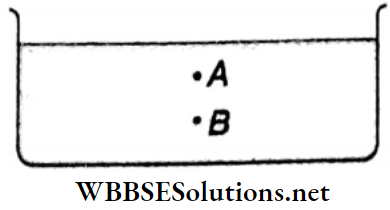
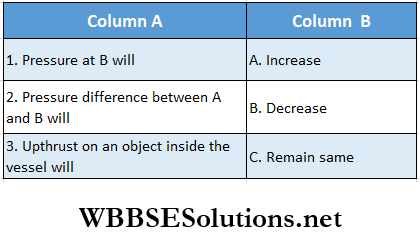
Answer: 1. A, 2. A, 3. A
Question 2. A cube is floating in a liquid as shown in Fig.
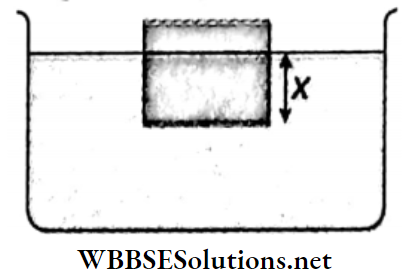
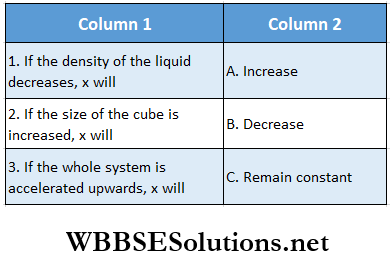
Answer: 1. B, 2. C. 3. C
Question 3. A tube is inverted in a mercury vessel as shown in Fig. If the pressure p is increased.
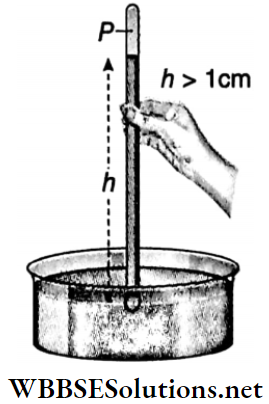
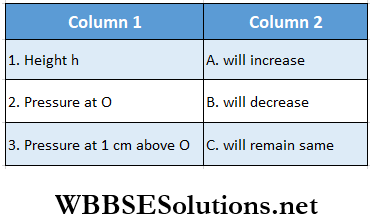
Answer: 1. 2, 2. C, 3. C
Question 4.
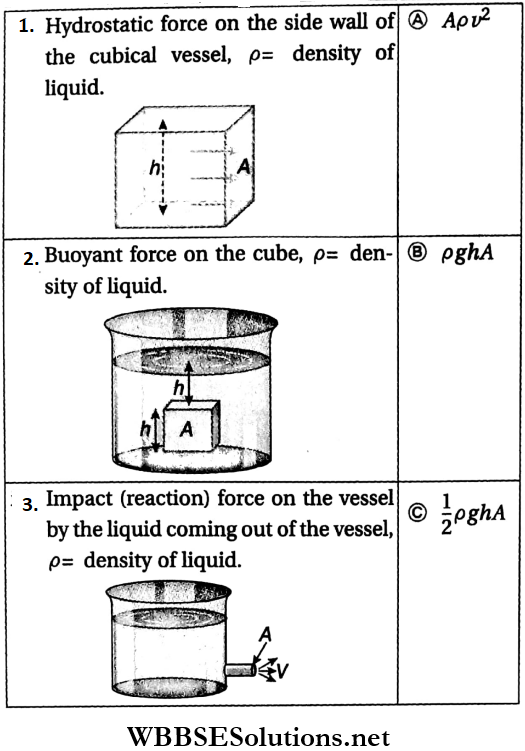
Answer: 1. C, 2. B, 3. A
Unit 7 Properties Of Bulk Matter Chapter 2 Hydrostatics Comprehension Type Question And Answers
Read the following passages carefully and answer the questions at the end of them.
Question 1. A small spherical ball of radius r is released from its completely submerged position in a liquid whose density varies with height h as \(\rho_L=\rho_0\left[4-\frac{3 h}{h_0}\right]\). The density of the ball is \(\frac{5}{2} \rho_0\). The height of the vessel is \(h_0=\frac{12}{\pi^2}\). Consider r <<h0 and g = 10 m • s-2
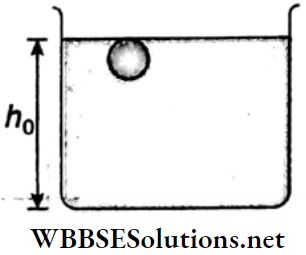
1. Where will the ball be in the equilibrium condition?
- at a depth \(\frac{h_0}{2}\) from top
- at the bottom of the vessel
- at a depth \(\frac{3h_0}{4}\) from top
- The ball will never be at equilibrium
Answer: 1. at a depth \(\frac{h_0}{2}\) from top
2. The motion of the ball in the vessel is
- Oscillatory but not SHM
- SHM with time period 2s
- SHM with time period 1 s
- The motion is not oscillatory
Answer: 2. SHM with time period 2s
3. Time taken by the ball to reach the bottom of the vessel is
- 1s
- 2s
- 0.5s
- The ball will not reach the bottom of the vessel.
Answer: 1. 1s
Question 2. A block of mass 1 kg and density 0.8 g · cm-3 is held stationary with the help of a string as shown in Fig. The tank is accelerating vertically upwards with an acceleration a = 1.0 m · s-2. Take g = 10 m • s-2 and density of water = 103 kg • m-3.
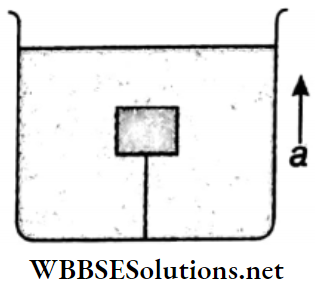
1. What is the tension in the string?
- 2.60 N
- 2.85 N
- 2.75 N
- 3.10 N
Answer: 3. 2.75 N
2. If the string is now cut, find the acceleration of the block
- 3.95 m • s-2
- 3.75 m • s-2
- 4.25 m • s-2
- 3.29 m • s-2
Answer: 2. 3.75 m • s-2
Question 3. An engineering firm is assigned the job to design the cylindrical pressured water tank for a future colony on Mars, where the acceleration due to gravity is 3.71 m • s-2. The pressure at the surface of the wafer will be 130 kPa and depth of the water will be 14.2 m- The pressure of the air in the building outside the tank will be 93 kPa.
1. Find the net downward force on the tank’s flat bottom of area 2 m2
- 179.4 kN
- 365.4 kN
- 105.36 kN
- None
Answer: 1. 179.4 kN
2. What is the buoyant force on a wooden block of mass 2 kg and relative density 0.8, height 10 cm?
- 5.94 N
- 7.42 N
- 1.48 N
- None
Answer: 2. 7.42 N
Question 4. The vessel shown in Fig. has two sections of areas of cross-section A1 and A2. A liquid of density ρ fills both the sections, up to a height h in each. Neglect the atmospheric pressure.
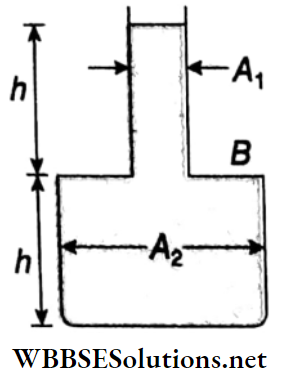
1. What is the pressure at the base of the vessel?
- 1/2 hρg
- 2hρg
- hρgA2
- None
Answer: 2. 2hρg
2. What is the force exerted by the liquid on the base of the vessel?
- 2hρg A1A2
- 1/2 hρg A2
- 2hρg A2
- hρg x (A1+A2)
Answer: 3. 2hpg A2
3. Find the downward force exerted by the walls of the vessel at the level B.
- 2hρg x (A2-A1)
- 1/2hρg x (A1 + A2)
- hρgA2
- hρg x (A2-A1)
Answer: 4. hρg x (A2-A1)
Question 5. A tank has a cylindrical hole H of diameter 2r at its bottom as shown in Fig. A cylindrical block B of diameter 4r and height h is placed on the hole H to prevent the flow of liquid through the hole. The liquid in the tank stands at a height h1 above the top face of the block. The density of liquid is ρ and that of the block is \(\frac{\rho}{3} .\).
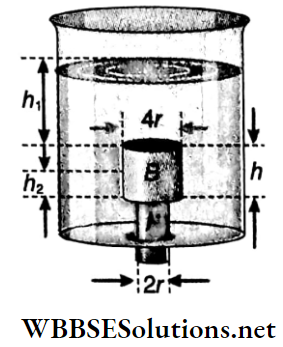
1. If the liquid is gradually taken out of the tank, the height h1 of the liquid surface above the top face of the block for which the block just begins to rise is
- 2h/4
- 3h/4
- 5h/3
- 2h
Answer: 3. 5h/3
2. If the liquid level is further lowered so that it stands at a depth h2 above the bottom face of the block as shown in the figure, then the maximum value of h2 so that the block does not move is
- 4h/9
- h/3
- 2h/3
- 5h/9
Answer: 1. 4h/9
3. If the liquid level is lowered below h2, then
- The block will never rise
- The block will start rising if h2 = h/3
- The block will start rising if h2 = h/4
- The block will start rising if h2 = h/5
Answer: 1. The block will never rise
Unit 7 Properties Of Bulk Matter Chapter 2 Hydrostatics Integer Type Question And Answers
In this type, the answer to each of the questions is a single-digit integer ranging from 0 to 9.
Question 1. A candle of diameter d is floating on a liquid in a cylindrical container of diameter D(D >>d) as shown in Fig It is burning at the rate of 2 cm • h-1. At what rate will the top of the candle fall?
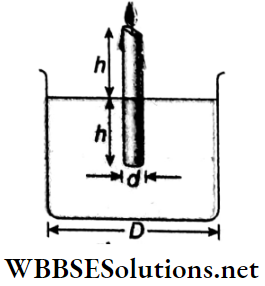 Answer: 1
Answer: 1
Question 2. A cylinder has radius 8 cm. Up to what height (in cm) should it be filled with water so that the thrust on its walls is equal to that on its bottom?
Answer: 8
Question 3. Mass of a balloon with its contents is 1.5 kg. It is descending with an acceleration equal to half of the acceleration due to gravity. If it is to go up with the same acceleration keeping the volume same, what amount of mass (in kg) should be decreased?
Answer: 1
Question 4. A ball whose density is 0.4 x 103 kg · m-3 falls into water from a height of 9 cm. To what depth does the ball sink?
Answer: 6
Question 5. A water tank is 20 m deep. If a water barometer reads 10 m at that place, then what is the pressure (in SI unit) at the bottom of the tank in the atmosphere?
Answer: 3
Unit 7 Properties Of Bulk Matter Chapter 2 Hydrostatics Short Answer Type Questions
Question 1. The density of a body is d and that of air is ρ. If the body weighs w in air, what will be its actual weight?
Answer:
The density of a body is d and that of air is ρ. If the body weighs w in air,
Let the actual weight of the body = w0
∴ buoyant force of air, B = \(\frac{w_0}{d} \rho\)
So, the weight of the body in air,
⇒ \(w=w_0-B=w_0-\frac{w_0}{d} \rho=w_0\left(\frac{d-\rho}{d}\right)\)
∴ \(w_0=\frac{d}{d-\rho} w\)
Question 2. A drop of oil rises through water with an acceleration ag. If a is a constant quantity and g is the acceleration due to gravity, find the specific gravity of the oil. Neglect the friction of water.
Answer:
A drop of oil rises through water with an acceleration ag. If a is a constant quantity and g is the acceleration due to gravity,
Let d and D be the density of water and oil respectively, and the mass of the oil drop is m.
∴ Volume of the oil drop = m/D
= volume of the displaced water by the oil drop or, the mass of the displaced water
= density of water x volume of the displaced water
= d x m/D
Now, buoyancy = weight of the displaced water = \(\frac{d m g}{D}\)
∴ Net upward force acting on the oil drop
= buoyant force – weight of the oil drop
= \(\frac{d m g}{D}-m g=\left(\frac{d}{D}-1\right) m g\)
∴ Acceleration of the oil drop inside water, \(\alpha g=\frac{\left(\frac{d}{D}-1\right) m g}{m}=\left(\frac{d}{D}-1\right) g\)
∴ Specific gravity of oil = \(/frac{D}{d}=\frac{1}{1+\alpha}\)
Question 3. A uniform rod is suspended horizontally from its mid-point. A piece of metal whose weight is W is suspended at a distance l from the mid-point. Another weight W1 is suspended on the other side at a distance l1 from the mid-point to bring the rod to a horizontal position. When W is completely immersed in water, W1 needs to be kept at a distance l2 from the mid-point to get the rod back into horizontal position. The specific gravity of the metal piece is
- \(\frac{W}{W_1}\)
- \(\frac{W l_1}{W l-W_1 l_2}\)
- \(\frac{l_1}{l_1-l_2}\)
- \(\frac{l_1}{l_2}\)
Answer:
In equilibrium condition of rod in air, Wl = W1l1
In equilibrium condition of rod immersed in water, \(\left(W-F_B\right) l=W_1 l_2\)
Where, FB = buoyant force on the body of weight W = \(\frac{W}{\rho}\)
So, \(\left(W-\frac{W}{\rho}\right) l=W_1 l_2=W_{\frac{l}{l}}^{l_1} l_2 \quad \text { or, } 1-\frac{1}{\rho}=\frac{l_2}{l_1}\)
∴ \(\rho=\frac{l_1}{l_1-l_2}\)
The option 3 is correct.
Question 4. A wooden block is floating on water kept in a beaker. 40% of the block is above the water surface. Now the beaker is kept inside a lift that starts going upward with acceleration equal to g/2. The block will then
- Sink
- Float with 10% above the water surface
- Float with 40% above the water surface
- Float with 70% above the water surface
Answer:
Weight of the body and the buoyancy of the liquid both depend on the effective acceleration. Hence there will be no change in the floating portion of the block.
The option 3 is correct.
Question 5. To determine the composition of a bimetallic alloy, a sample is first weighed in air and then in water. These weights are found to be w1 and w2 respectively. If the densities of the two constituent metals are p1 and p2 respectively, then the weight of the first metal in the sample is (where pw is the density of water)
- \(\frac{\rho_1}{\rho_{w^{(}}\left(\rho_2-\rho_1\right)}\left[w_1\left(\rho_2-\rho_w\right)-w_2 \rho_2\right]\)
- \(\frac{\rho_1}{\rho_w\left(\rho_2+\rho_1\right)}\left[w_1\left(\rho_2-\rho_w\right)+w_2 \rho_2\right]\)
- \(\frac{\rho_1}{\rho_w^{(}\left(\rho_2-\rho_1\right)}\left[w_1\left(\rho_2+\rho_w\right)-w_2 \rho_1\right]\)
- \(\frac{\rho_1}{\rho_w\left(\rho_2-\rho_1\right)}\left[w_1\left(\rho_2-\rho_w\right)-w_2 \rho_1\right]\)
Answer:
⇒ \(w_1-w_2=V \rho_w g=\left(V_1+V_2\right) \rho_w g=\left[\frac{x}{\rho_1}+\frac{w_1-x}{\rho_2}\right] \rho_w\)
Hence, required weight,
x = \(\frac{\rho_1}{\rho_w\left(\rho_2-\rho_1\right)}\left[w_1\left(\rho_2-\rho_w\right)-w_2 \rho_2\right]\)
The option 1 is correct.
Question 6. A cylinder of height h is filled with water and is kept on a block of height h/2. The level of water in the cylinder is kept constant. Four holes numbered 1, 2, 3, and 4 are at the side of the cylinder and at heights 0, h/4 , h/2, and 3h/4 respectively. When all four holes are opened together, the hole from which water will reach farthest distance on the plane PQ is the hole number
- 1
- 2
- 3
- 4
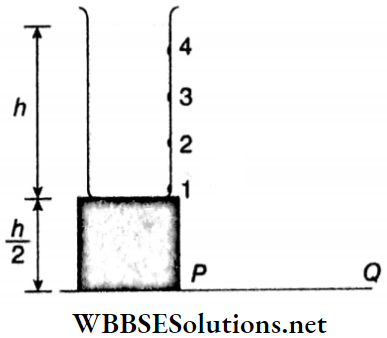
Answer:
Net height of the block and the cylinder = \(\frac{h}{2}+h=\frac{3 h}{2}\)
If we consider a hole at a depth x from the top, height of that hole from the plane PQ, H = 3h/2 – x
Velocity of water flowing out of that hole horizontally, v = √2gx
Now, vertical velocity of water flowing out of that hole = 0
Hence, if the water takes t time to reach PQ plane,
H = \(\frac{1}{2} g t^2 \quad \text { or, } t=\sqrt{\frac{2 H}{g}}\)
For this time t, water will flow horizontally with the same velocity.
Hence, distance travelled on the PQ plane, \(D=v t=\sqrt{2 g x} \cdot \sqrt{\frac{2 H}{g}}=\sqrt{2 x \cdot 2 H}=\sqrt{2 x(3 h-2 x)}\)
For hole no. \(1, x=h ; D_1=\sqrt{2 h(3 h-3 h)}=h \sqrt{2}\)
For hole no. \(2, x=\frac{3 h}{4} ; D_2=\sqrt{\frac{3 h}{2}\left(3 h-\frac{3 h}{2}\right)}=h \cdot \frac{3}{2}\)
For hole no. \(3, x=\frac{h}{2}, D_3=\sqrt{h(3 h-h)}=h \sqrt{2}\)
For hole no. \(4, x=\frac{h}{4} ; D_4=\sqrt{\frac{5 h}{2}\left(3 h-\frac{5 h}{2}\right)}=h \sqrt{\frac{5}{4}}\)
∴ \(D_2>D_1=D_3>D_4\)
The option 2 is correct.
Question 7. There is a circular tube in a vertical plane. Two liquids that do not mix and of densities d1 and d2 are Filled in the tube. Each liquid subtends 90° angle at centre. Radius joining their interface makes an angle a vertical. Ratio d1/d2 is
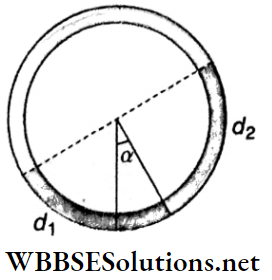
- \(\frac{1+\sin \alpha}{1-\sin \alpha}\)
- \(\frac{1+\cos \alpha}{1-\cos \alpha}\)
- \(\frac{1+\tan \alpha}{1-\tan \alpha}\)
- \(\frac{1+\sin \alpha}{1-\cos \alpha}\)
Answer:
Equating pressure at A, (Rcosa + Rsina)d2g (Rcosa – Rsina)d1g
⇒ \(\frac{d_1}{d_2}=\frac{\cos \alpha+\sin \alpha}{\cos \alpha-\sin \alpha}=\frac{1+\tan \alpha}{1-\tan \alpha}\)
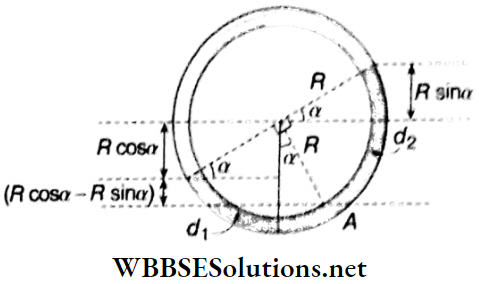
The option 3 is correct.
Question 8. An open glass tube is immersed in mercury in such a way that a length of 8 cm extends above the mercury level. The open end of the tube is then closed and sealed and the tube is raised vertically up by additional 46 cm. What will be length of the air column above mercury in the tube now? (Atmospheric pressure = 76 cm of Hg)
- 16cm
- 22 cm
- 38 cm
- 6 cm
Solution:
⇒ \(p+x=p_0\)
or, \(p=p_0-x\)
or, \(8 \times A \times 76=(76-x) \times A \times(54-x)\)
∴ x=38
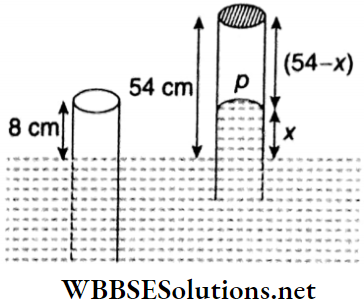
So, length of air column =54-38 = 16 cm.
The option 1 is correct.
Question 9. Two non-mixing liquids of densities p and np(n > 1) are put in a container. The height of each liquid is h. A solid cylinder of length L and density d is put in this container. The cylinder floats with its axis vertical and length pL(p < 1) in the denser liquid. The density d is equal to
- {2 + (n+ 1)p}ρ
- {2 + (n- 1)p}ρ
- {1 +(n-1)p}ρ
- {1 + (n+1)p}ρ
Answer:
Let, the area of the cross-secton of the cylinder be A.
Weight of the cylinder = LAgd
The buoyant force on the cylinder due to the liquid of higher density = pLAnρg
and buoyant force on the cylinder due to the liquid of lower density = (1- p)LAρg
In equilibrium,
LAgd = (1 – p)LAρg+ pLAnρg
or, d = (1 -ρ)ρ + pnρ = ρ-pρ + pnρ
∴ d = [1 +(n- l)p]ρ
The option 3 is correct.

